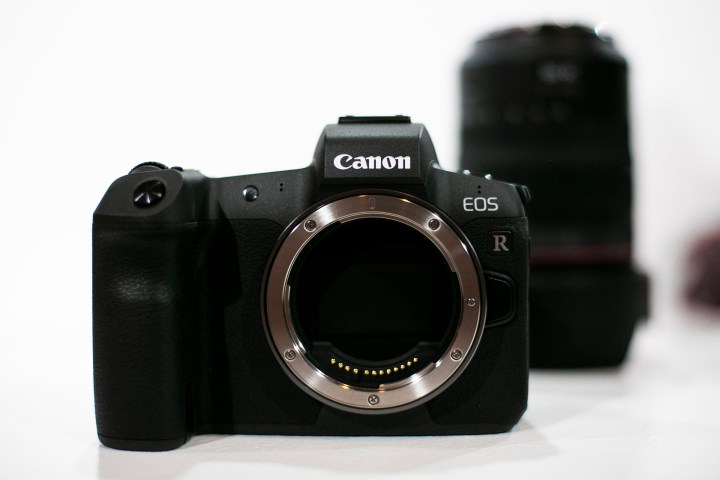
To back up the launch of its EOS R System, Canon unveiled four new lenses and three new adapters for its brand-new RF lens mount. The two zoom and two prime lenses pave the way for the future by taking advantage of the new engineering capabilities afforded by Canon’s next-generation lens mount, the company says, while the three adapters ensure the more than 130 million EOS lenses on the market won’t get left behind.
RF lenses
Before diving into the individual lenses, it’s worth noting each of the four lenses feature a new programmable lens control ring. This physical ring on the lens lets you control things like ISO, aperture, exposure compensation, and more with a simple twist — similar to the focus and zoom rings on the lenses. In an age when more settings are getting put behind convoluted menus, it’s nice to see Canon cleverly creating a way to quickly change settings on the fly using an underutilized area of a camera system.
Canon RF 24-105mm F/4 L IS USM

Similar to its EF equivalent, the Canon RF 24-105mm f/4 L IS is designed to be the — relatively — affordable workhorse of the bunch. The 24-105mm focal length offers a lot of range in a compact design and the image stabilization gives up to 5 stops of compensation. The constant f/4 aperture should also help when shooting in low-light conditions — not to mention you won’t have to worry about accidental exposure differences when zooming in, as is the case with variable aperture lenses. The Canon RF 24-105mm f/4 L IS USM will launch in December 2018 for $1,099.99.
Canon RF 28-70mm F/2 L USM

As noted by Canon in its presentation, the Canon RF 28-70mm f/2 L is the world’s first standard zoom lens with a constant f/2 aperture. Much beefier in size than the 24-105mm due to its larger optical elements, the 28-70mm f/2 looks and feels like a tank when attached to the Canon EOS R camera. The Canon RF 28-70mm f/2 L is set to launch in December 2018 with an MSRP of $2,999.99.
Canon RF 35mm F/1.8 Macro IS STM

Getting to the primes, the Canon 35mm f/1.8 Macro IS STM is a quirky little standard lens. Its fast f/1.8 aperture and 35mm focal length make it the perfect lifestyle lens, even in low-light conditions, thanks to its image stabilization. If you’re feeling a bit wild though (or simply enjoy close-up photography) you can also use the 35mm f/1.8 as a macro lens, thanks to its close 0.56-feet/0.7m minimum focusing distance and 0.5x magnification ratio. The Canon RF 35mm f/1.8 Macro IS STM is set to launch in December 2018 for an MSRP of $499.99.
Canon RF 50mm F/1.2 L USM

While not as fast as Nikon’s ridiculous f/0.95 Noctilux lens, Canon’s RF 50mm f/1.2 L is more than enough to get that creamy smooth bokeh and shallow depth of field. In Canon’s own words, the fast f/1.2 aperture “means amazing performance in low light [conditions] and gorgeous, detailed images with evocative background blur.” As you would expect for such a fast lens, this thing is a monster and looks beautiful when paired with the EOS R camera. The Canon RF 50mm F/1.2 L USM will be available for $2,299 starting October 2018.

RF adapters

As we were expecting in the event of the Canon EOS R having a new lens mount, Canon has released three new adapters for mounting EF and EF-S lenses to the new RF lens mount, each of which has its own specialized purpose.
Mount Adapter EF-EOS R

First up is the most humble of the adapter — a no-frills EF-to-RF adapter. The compact adapter ensures full compatibility with all autofocus and image stabilization features of past and present EF and EF-S lenses — of which more than 130 million exist. The Mount Adapter EF-EOS R is set for an October 2018 arrival for $99.99.
Control Ring Mount Adapter EF-EOS R

We mentioned above that Canon introduced a new customizable control ring for each of the four lenses it’s announced for the EOS R System. Well, this adapter manages to add the exact same control ring directly onto the adapter, giving you a programmable physical dial when using EF and EF-S lenses. The Control Ring Mount Adapter EF-EOS R is set to launch in October 2018 for $199.99.
Drop-in Filter Mount Adapter EF-EOS R

As the (lengthy) name alludes to, this EF to RF adapter gives you the ability to add a drop-in neutral density or circular polarizing filter to any lens you attach to it. Now, you can use filters with lenses that it would’ve otherwise been almost impossible to do with, such as Canon’s EF 8-15mm F/4 L fisheye lens. The Drop-in Filter Mount Adapter EF-EOS R is set for a February 2019 launch starting at $299.99 for the polarizing filter version and $399.99 for the variable ND filter version.
Editors' Recommendations
- Lens teardown reveals how Canon made an affordable super-telephoto
- Canon’s affordable new full-frame mirrorless lenses are exactly what it needed
- Canon’s new mirrorless lenses come with impressive specs — and high costs



